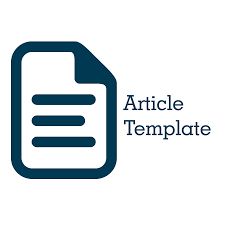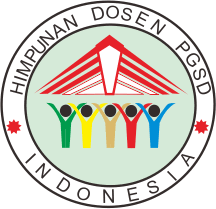Implementasi projek penguatan profil pelajar pancasila di sekolah dasar
Abstract
The purpose of the research conducted was to find out the implementation project for strengthening the profile of Pancasila students at Tegalrejo 98 Surakarta State Elementary School for the 2022/2023 academic year, which includes preparation, implementation, and evaluation.
This research uses the descriptive-qualitative method. The informants used in this study were three people, including school principals, grade 1 teachers, and grade 2 teachers, who worked at Tegalrejo 98 Elementary School in Surakarta. Data collection was carried out through observation and interviews. The researcher acts as a research instrument.
The results of this study found that project planning to strengthen the profile of Pancasila students (P5) at Tegalrejo 98 Surakarta State Elementary School included: 1) Setting the theme; 2) Establishing a committee; 3) Determine the project to be carried out; 4) Determining the implementation time 5) Doing filing While the implementation of P5 at Tegalrejo 98 Surakarta State Elementary School is carried out twice a year, Meanwhile, the figures involved in the implementation of P5 included school principals, committees, teachers, students, parents, and education staff. Furthermore, the findings from evaluating the implementation of P5 at Tegalrejo 98 Surakarta State Elementary School include: 1) How to evaluate P5, namely by adjusting implementation to planning Another assessment is carried out by assigning a value according to the project report card. 2) The P5 assessment aspect refers to the six profiles of Pancasila Students; 3) Assessment consists of two subjects, namely individual assessment and group assessment; 4) The assessment given is based on the process of making the project and the assessment given directly by the audience; 5) The P5 assessment that is carried out is the process of students preparing and checking P5 at the end of the semester. 6) In the reporting activity, the school asks for input and suggestions from parents so that P5 goes better in the future. 7) Obstacles in the P5 evaluation at Tegalrejo Public Elementary School, namely the absence of a standard assessment on the P5 evaluation, limited time, unfavorable situations and conditions, and the division of time for the agenda and standing arrangement time; 8) Anticipating obstacles in the P5 evaluation, namely by giving more time for each agenda so that the assessment can be maximized, disciplining students so as not to disturb the event's congestion, and the teacher previously tightening the assessment of the performers
Keywords
Full Text:
PDFReferences
L. E. Retnaningsih and U. Khairiyah, “Kurikulum merdeka pada pendidikan anak usia dini,” SELING J. Progr. Stud. PGRA, vol. 8, no. 1, pp. 143–158, 2022. [2] Kemendikbud, “Dorong Pemulihan Pembelajaran di Masa Pandemi , Kurikulum Nasional Siapkan Tiga Opsi,” 2022. [3] Kemendikbud, “Kurikulum Merdeka Jadi Jawaban untuk Atasi Krisis Pembelajaran,” 2022. [4] Mery, Martono, S. Halidjah, and A. Hartoyo, “Sinergi Peserta Didik dalam Proyek Penguatan Profil Pelajar Pancasila,” J. Basicedu, vol. 6, no. 5, pp. 7840–7849, 2022, doi: 10.31004/basicedu.v6i5.3617. [5] R. C. Bogdan and S. K. Biklen, for Education An Introduction to Theory and Methods. Boston: Allyn and Bacon, 1992. [6] Sugiyono, Metode Penelitian Kuantitatif, Kualitatif, dan R&D. Bandung: Alfabeta, 2021. [7] F. Ramadhan, D. Puspitasari, and T. Yanto, “Perencanaan Stratejik Pendidikan Melalui Project Penguatan Profil Pelajar Pancasila Di SMP Negeri 38 Bandung,” Al Afkar J. Islam. Stud., vol. 6, no. 2, pp. 353–365, 2023, doi: 10.31943/afkarjournal.v6i2.559.Educational. [8] I. Y. Zuhriyah, M. Subandow, and H. Karyono, “PELAKSANAAN PROYEK PENGUATAN PROFIL PELAJAR PANCASILA : STUDI DI SMA NEGERI 4 PROBOLINGGO,” PeTeKa J. Penelit. Tindakan Kelas dan Pengemb. Pembelajaran, vol. 6, no. 2, pp. 319–328, 2023. [9] G. Santoso, A. Damayanti, M. Murod, and S. Imawati, “Implementasi Kurikulum Merdeka melalui Literasi Proyek Penguatan Profil Pelajar Pancasila,” J. Pendidik. Transform., vol. 02, no. 01, pp. 84–90, 2023. [10] M. R. Hamzah, Y. Mujiwati, I. M. Khamdi, M. I. Usman, and M. Z. Abidin, “Proyek Profil Pelajar Pancasila sebagai Penguatan Pendidikan Karakter pada Peserta Didik,” J. Jendela Pendidik., vol. 2, no. 04, pp. 553–559, 2022, doi: 10.57008/jjp.v2i04.309. [11] A. Fery, “Sistem Manajemen Boarding School Dalam Membentuk Karakter Siswa Melalui Implementasi Project Penguatan Profile Pelajar Pancasila ( P5 ) Di SMSA Al Mumtaz Kota Solok,” Innov. J. Soc. Sci. Res. Vol., vol. 3, no. 2, pp. 8845–8856, 2023. [12] N. Agustina, I. S. Ramdhani, and Enawar, “Analisis Gerakan Literasi Pojok Baca Terhadap Minat Baca Kelas 4 SDN Bojong 04,” Al-Irsyad, vol. 105, no. 2, p. 79, 2022, [Online]. Available: https://core.ac.uk/download/pdf/322599509.pdf [13] D. M. Sulistyati, S. Wahyaningsih, and I. W. Wijania, Projek Penguatan Profil Pancasila. Jakarta: Pusat Kurikulum dan PErbukuan Badan Penelitian dan Pengembangan dan Perbukuran Kementerian Pendidikan dan Kebudayaan, 2021. [14] S. Sufyadi, T. Y. Harjatanaya, P. Adiprima, R. Satria, A. Andiarti, and I. Herutami, Panduan Pengembangan Projek Penguatan Profil Pelajar Pancasila. Jakarta: Kementerian Pendidikan Dan Kebudayaan, 2021. [15] Hamdani, Strategi Belajar Mengajar. Bandung: Pustaka Setia, 2011.
Refbacks
- There are currently no refbacks.



